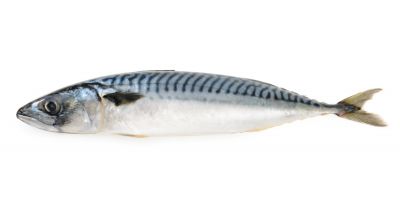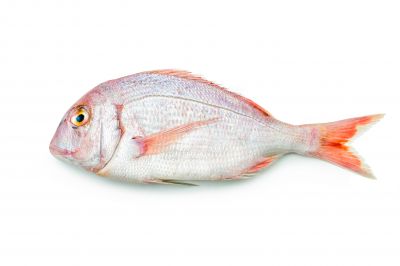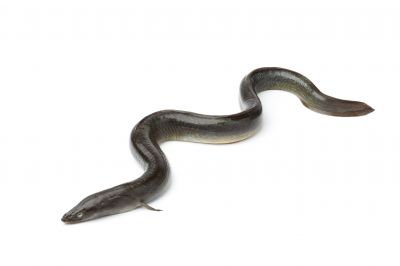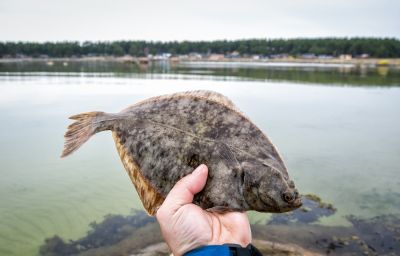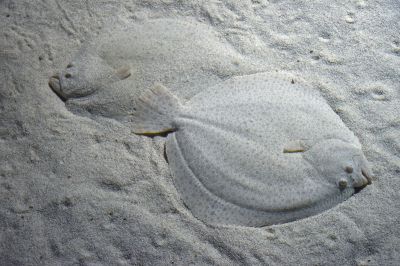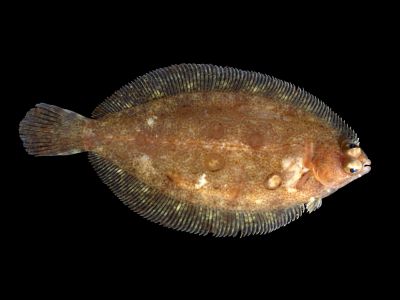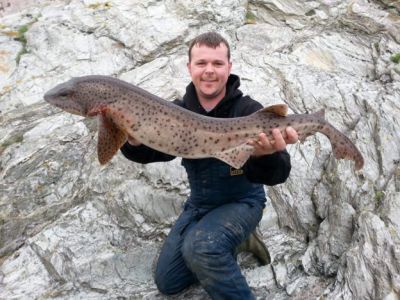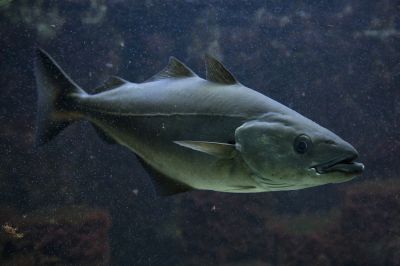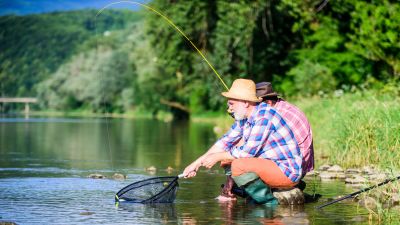
Discover everything to fish in Cockenzie and Port Seton
Find the best moment to go fishing in Cockenzie and Port Seton, the most caught species, the techniques used, go fish with anglers nearby, find a fishing charter or guide, save your spots and discover new ones.
Go for it!Fishing spots mapDiscover the best fishing spots in Cockenzie and Port Seton
Fishing in Cockenzie and Port Seton
What can I fish there ?Join our 588 fishermen in Cockenzie-and-Port-Seton in East Lothian. The fishing forecast is currently 3.3. The most caught fishes here are the european eel, the red bream, the smoothhound fish and the brill fish. Come try the most famous fishing techniques like the slabbing the bass, support fishing for bass, float fishing (plug) or tips on material for sea bream throwing.

Fishing forecast : go fishing at the best time!
4.2
11h40
It starts to bite,
but games are not done.
Exclusiveness
The fishing forecast
Discover the scientific algorithm that gives you the best moment to go fishing at Cockenzie and Port Seton !
This is a score calculated according to about forty criteria: moon, weather conditions, atmospheric pressure, tides, swell ...
. Forecast calculated at 4 days

Most caught fish species in Cockenzie and Port Seton Top species caught by Club members
Top species caught by Club members
N°1 | The Mackerel fish
The Mackerel fish belongs to the Scombridae family. The average size of adult mackerel is 30 to 40 cm and its weight ranges from 500 g to exceptionally 1.5 kg. It can live up to 17 years. It reproduces from March to September. The female can lay 450000 eggs. It can be fished all year round. The streamlined body and pointed head of the mackerel, give it an excellent swimming quality (up to 10 km/h). The characteristic feature of mackerel is its blue-green back zebra with more or less oblique and parallel dark lines, while the sides and belly are silvery white. There are 23 to 33 dark chevrons depending on the individual and include the forehead between the two eyes. The fins of mackerel are grey. It has two widely spaced dorsal fins, the first being characterized by 10 to 13 thorny rays. In addition, it also has two pectoral fins (dark based), two ventral, one anal and one caudal. The caudal is preceded by 5 small feathered fins on the dorsal and ventral sides called pinnules. The tail is very indented.
Fishing period : All year
Minimum size : 20 cm
Difficulty : ![]()
![]()
![]()
![]()
![]()
N°2 | The Red Bream
The Red Bream belongs to the Sparidae Family. The Red bream is a fish with a common length of 15 to 30 cm, the maximum known size being 60 cm. This fish can live for about twenty years. It breeds from May to August or March to July. Although it is fished all year round, it is between fall and winter that catches increase. The body is oval in shape, compressed laterally, as in most Sparidae. The head has an almost straight profile, a pointed snout, a fairly small mouth in a low and inclined position. The diameter of the eye is much smaller than the length of the muzzle. The inside of the mouth is greyish or whitish. The 2 jaws have sharp teeth in front (larger outer teeth, with small teeth) and 2 or 3 rows of molar-shaped teeth in the back. Like all Sparidae, it has only one dorsal fin. It begins at the plumbing of the pelvic bones and includes 12 spines and 10 to 11 soft rays. The anal fin has 3 spines and 8 to 9 soft rays, the length of its base is one-third that of the dorsal fin. The pectoral fins are high and very long, reaching almost vertically from the beginning of the anal fin. The caudal fin is forked. The body color is silvery pink with bluish reflections, the back and top of the head being darker. The upper part of the body is dotted with small blue spots. The upper outer edge of the lid is marked with a carmine red. The bases of the pectoral fins have a reddish spot and sometimes a spot is also observed at the base of the last rays of the dorsal fin.
Fishing period : All year
Minimum size : 15 cm
Difficulty : ![]()
![]()
![]()
![]()
![]()
N°3 | Seabass
The Seabass belongs to the Moronidae family. Its size is usually between 70 and 80 cm (1.10 m maximum). The life expectancy of the seabass is variable: about thirty years in an aquarium, 24 years in Ireland, 6 years maximum most often in the Mediterranean. Breeding takes place between December and March or January to May depending on the location. The female lays 200,000 eggs at once. The body of this fish is elongated and slightly compressed. The two dorsal fins (the first thorny and the second soft) are well separated and have almost the same length and height. The anal fin is composed of 10 soft rays preceded by 3 thorny rays. The caudal peduncle is quite elongated and the caudal fin is indented, with an upper lobe often slightly longer than the lower lobe. The pectoral fins are short. The upper part of the head is quite straight, the upper jaw is a little shorter than the lower jaw. The operculum may have a more or less visible black spot in its posterior upper part. The scales are small in size but clearly visible. The lateral line is slightly arched in the front part of the body. The back is grey in color, the sides are lighter, with yellowish or silvery reflections. The pectoral and ventral fins are yellowish white; the others are darker. Mostly in young individuals, black spots may be present in the dorso-ventral region.
Fishing period : Refer to section below
Minimum size : 40 cm
Difficulty : ![]()
![]()
![]()
![]()
![]()
N°4 | The European Eel
The European Eel belongs to the Anguillidae family. The european eel can reach a maximum size of 1.50 m and a weight of 3 kg. However, males rarely exceed 45 cm. The current size is more modest and varies between 40 and 60 cm. Its longevity is 12 to 20 years but in captivity it can reach more than 50 years. They can be fished from June to September. The European eel has a snake-like body, with a circular cross-section and very elongated. The body is covered with smooth, viscous skin, rich in thick mucus-secreting cells. The scales are small, oval and deeply embedded in the skin. It has a small round eye and a terminal mouth. The lower jaw is prominent. The color of the eel varies as it grows. In the yellow eel stage, it has a brownish, greenish or yellowish color depending on its habitat (homochrome). The lateral line is not very visible. In the silver eel stage, the back is dark green, the sides have silvery highlights and the belly is pearly white. The lateral line becomes very visible. The body of the European eel does not have pelvic fins. The pectoral fins, the only even fins, are small. On the other hand, odd fins (dorsal, anal, caudal) are very long and fuse at the tail.
Fishing period : June to September
Minimum size : 38 cm
Difficulty : ![]()
![]()
![]()
![]()
![]()
N°5 | The Flounder Fish
The Flounder Fish belongs to the Pleuronectidae family. It usually reaches a size of 50 cm; the maximum observed size is 60 cm for a weight of 1.5 kg. The maximum lifespan is estimated at 15 years. It reproduces in early spring. The female can lay up to 2 million eggs. The best time to fish it is in spring and autumn. The Flounder fish is a flatfish of general losanitary appearance, taking into account the triangular shape of the head and dorsal and anal fins. Both eyes are on the same side of the head, on the right side, for about 2/3 of the individuals. The mouth is small and terminal, with a slightly tapered snout. The oral commissure is located on the same line as the center of the eye. The lateral line barely curves towards the dorsal edge at the pectoral fins. It has a row of tubers in its front part. Similarly, the base of the dorsal and anal fins is highlighted by a line of tubers, which are clearly palpable. The anal fin has 35 to 46 soft rays. The oculate side has a variable coloring, from olive green to reddish brown, or grey, enhanced by dark green mottling, with small, dull and few orange spots. This helps to give it a "dirty" appearance. The blind side is white.
Fishing period : Spring and Autumn
Minimum size : 25 cm
Difficulty : ![]()
![]()
![]()
![]()
![]()
N°6 | The Pollack fish
The Pollack fish belongs to the Gadidae family. Its size can reach 1.40 m for an average of 60 to 80 cm. The Pollack grows very quickly and lives between 8 and 10 years, while most pelagic fish have a lifespan of more than 20 years. Reproduction takes place in February March. Fertility can reach 4 million eggs. It can be fished all year round. Elongated body, covered with small scales, orange-yellow color, darker on the back, marbled in young individuals, bright yellowish white in adults. Prominent lower jaw, big eye. The dark-colored lateral line is curved at the pectoral fins, which makes it easily distinguishable from the black locus (Pollachius virens) in which it is straight. The Pollack, like many Gadidae, has three clearly triangular dorsal fins and two anal fins. It is one of the few Gadidae that does not have chin barbells. Juveniles are rather reddish brown with longitudinal stripes of blue-grey.
Fishing period : All year
Minimum size : 30 cm
Difficulty : ![]()
![]()
![]()
![]()
![]()
N°7 | The Brill fish
The brill fish belongs to the Scophthalmidae family. The minimum size of capture is 30 cm but can reach 75 cm for 6 kg. He can live up to 3 years. It breeds from late spring to early summer. The female can lay up to 15 million eggs. It can be fished all year. The brill has an oval body. It rests on its right side and has its left side. Thus, when placed with the head facing left, both eyes are located above the mouth. Its common name of brill comes from a particularity of its dorsal fin, whose origin is far in front of the eye and whose first rays are free and branched. The distance between the two eyes is greater than the diameter of one eye. The lateral line is very curved at the pectoral fin. As with many flatfish, the coloring is variable and depends on the biotope. The brill is indeed capable of homochromia, i.e. to match the color of the background. The coloring is rather brown, more or less speckled, and also varies according to the environment on a live fish. It has many round spots whose edges are incomplete rings of darker colors. The blind side is whitish.
Fishing period : All year
Minimum size : 30 cm
Difficulty : ![]()
![]()
![]()
![]()
![]()
N°8 | The Halibut fish
The Halibut fish belongs to the Pleuronectidae family. It can measure up to 4 m, weigh more than 100 kg and live to be 50 years old. It breeds from February to May and lays up to one million eggs. the fishing season is open from March to November. Halibut is a flatfish of the Pleuronectidae family. Like all fish in this family, its eyes are both located on the right side of his head (dexter fish), with the left side blind and unpigmented facing the ground. Its body is elongated, its lateral line strongly arched in the pectoral region, its mouth wide, its teeth curved and its tail concave. The color of its right flank (upper flank) varies from greenish grey to dark brown, while its left flank ranges from white to pale grey.
Fishing period : More productive in Spring
Minimum size : 81 cm
Difficulty : ![]()
![]()
![]()
![]()
![]()
N°9 | The Sole Fish
The sole fish belongs to the Soleidae family. The maximum size can reach 70 cm with a current size of 25 to 35 cm. Its longevity is 27 years. It breeds from January to March depending on the region. It can lay up to 1,300,000 eggs. It can be fished all year round. First of all, we notice in this flatfish its characteristic oval shape, which is not found in the other flatfish most frequently encountered by divers. The adult sole, a right-handed (or dexter) flatfish, rests on its left flank and has its eyes on the right side. The color of this fish is very variable: bluish grey to yellowish brown! The body is often marked with marbling and dark spots. The snout of the soles is rounded and shows a small arched mouth, located before the tip of the head. Her eyes are small and wide apart. The caudal has a rounded edge at the end of which a dark fringe can often be seen. On the seabed is the black spot (sometimes golden or brown) at the back and up of the pectoral fin. The dorsal and anal fins are generally white bordered and joined to the caudal by a thin membrane.
Fishing period : All year
Minimum size : 24 cm
Difficulty : ![]()
![]()
![]()
![]()
![]()
N°10 | Black Bream Fish
The Black breamfish, also known as Acanthopagrus butcheri, is a Sparidae. In general, its average size is 15 to 35 cm and its weight is 500 g to 2.5 kg. However, some individuals can reach up to 60 cm and 4 kg. The black bream has a lifespan of 27 years. Its spawning period is between August and January. It can have up to 300,000 spawn each season. It is not hard to catch and offer a little resistance. The Black bream has a high body and relatively compressed laterally, with symmetrically curved dorsal and ventral fins. The mouth is of moderate size compared to the body and has six incisors in the front of the lower and upper jaws. The body is covered with large scales that can be cycloid or slightly ctenoid. The head is essentially flake-free, except for the lids. A flake sheath covers the soft ray bases of the dorsal, anal and caudal fins. The Black Bream is silvery, from golden brown or bronze to grey-green on the back as well as on the sides with sometimes greenish reflections, depending on its habitat. The belly is white. The fins are all dark, with black borders. The caudal fin is often dark olive-brown.
Fishing period : All year
Minimum size : 25 cm
Difficulty : ![]()
![]()
![]()
![]()
![]()
N°11 | The Bull Huss
The Bull Huss belongs to the Scyliorhinidae family. Small in size, they usually measure 60 to 80 cm, although there are larger ones, since they can reach 1.5 m in the Mediterranean and 2 m in the Atlantic. This fish can live for 75 years. It spawns a hundred eggs all year round, especially in the late winter and in July. It is abundant every day of the year. This fish is not really active but still is hard to catch. The upper part of the Bull Huss is light brown in color, covered with small dark brown spots. Because of this pattern of spots, it is also called spotted cat shark. The part of the flank is white and grey. The mouth and nose holes are below his obtuse head. The particularity of the Bull Huss is that its nostrils are linked to the mouth by a curved line.
Fishing period : All year
Minimum size : 58 cm
Difficulty : ![]()
![]()
![]()
![]()
![]()
N°12 | The Coalfish
The Coalfish belongs to the Gadidae family. With a size of up to 1.30 m, the coalfish can weigh up to 10 kg. It has a life span of 8 to 10 years. The breeding period varies according to the location. The female lays up to 4 million eggs. It can be fished all year round but at a minimum catch size of 61 cm. Its body is fusiform and elongated, covered with small round scales. In profile, the lower jaw is slightly prominent. The back is greenish brown; the belly is silvery. The clear and almost straight lateral line is well marked. It extends along the entire length of its sides. There may also be a black spot at the base of the pectoral fins. The mouth is terminal. She's black on the inside. The fins are soft-raked. They are dark like the back of a fish, except for the lighter pelvic fins. The coalfish has 3 dorsal fins, the first being triangular, the others longer, and 2 anal fins. The pelvic fins are positioned well forward, under the head, and the caudal fin is a little concave. Young people may have a small barbel on their chin.
Fishing period : All year
Minimum size : 61 cm
Difficulty : ![]()
![]()
![]()
![]()
![]()
N°1 | The Mackerel fish
The Mackerel fish belongs to the Scombridae family. The average size of adult mackerel is 30 to 40 cm and its weight ranges from 500 g to exceptionally 1.5 kg. It can live up to 17 years. It reproduces from March to September. The female can lay 450000 eggs. It can be fished all year round. The streamlined body and pointed head of the mackerel, give it an excellent swimming quality (up to 10 km/h). The characteristic feature of mackerel is its blue-green back zebra with more or less oblique and parallel dark lines, while the sides and belly are silvery white. There are 23 to 33 dark chevrons depending on the individual and include the forehead between the two eyes. The fins of mackerel are grey. It has two widely spaced dorsal fins, the first being characterized by 10 to 13 thorny rays. In addition, it also has two pectoral fins (dark based), two ventral, one anal and one caudal. The caudal is preceded by 5 small feathered fins on the dorsal and ventral sides called pinnules. The tail is very indented.
Fishing period : All year
Minimum size : 20 cm
Difficulty : ![]()
![]()
![]()
![]()
![]()
N°2 | The Red Bream
The Red Bream belongs to the Sparidae Family. The Red bream is a fish with a common length of 15 to 30 cm, the maximum known size being 60 cm. This fish can live for about twenty years. It breeds from May to August or March to July. Although it is fished all year round, it is between fall and winter that catches increase. The body is oval in shape, compressed laterally, as in most Sparidae. The head has an almost straight profile, a pointed snout, a fairly small mouth in a low and inclined position. The diameter of the eye is much smaller than the length of the muzzle. The inside of the mouth is greyish or whitish. The 2 jaws have sharp teeth in front (larger outer teeth, with small teeth) and 2 or 3 rows of molar-shaped teeth in the back. Like all Sparidae, it has only one dorsal fin. It begins at the plumbing of the pelvic bones and includes 12 spines and 10 to 11 soft rays. The anal fin has 3 spines and 8 to 9 soft rays, the length of its base is one-third that of the dorsal fin. The pectoral fins are high and very long, reaching almost vertically from the beginning of the anal fin. The caudal fin is forked. The body color is silvery pink with bluish reflections, the back and top of the head being darker. The upper part of the body is dotted with small blue spots. The upper outer edge of the lid is marked with a carmine red. The bases of the pectoral fins have a reddish spot and sometimes a spot is also observed at the base of the last rays of the dorsal fin.
Fishing period : All year
Minimum size : 15 cm
Difficulty : ![]()
![]()
![]()
![]()
![]()
N°3 | Seabass
The Seabass belongs to the Moronidae family. Its size is usually between 70 and 80 cm (1.10 m maximum). The life expectancy of the seabass is variable: about thirty years in an aquarium, 24 years in Ireland, 6 years maximum most often in the Mediterranean. Breeding takes place between December and March or January to May depending on the location. The female lays 200,000 eggs at once. The body of this fish is elongated and slightly compressed. The two dorsal fins (the first thorny and the second soft) are well separated and have almost the same length and height. The anal fin is composed of 10 soft rays preceded by 3 thorny rays. The caudal peduncle is quite elongated and the caudal fin is indented, with an upper lobe often slightly longer than the lower lobe. The pectoral fins are short. The upper part of the head is quite straight, the upper jaw is a little shorter than the lower jaw. The operculum may have a more or less visible black spot in its posterior upper part. The scales are small in size but clearly visible. The lateral line is slightly arched in the front part of the body. The back is grey in color, the sides are lighter, with yellowish or silvery reflections. The pectoral and ventral fins are yellowish white; the others are darker. Mostly in young individuals, black spots may be present in the dorso-ventral region.
Fishing period : Refer to section below
Minimum size : 40 cm
Difficulty : ![]()
![]()
![]()
![]()
![]()
N°4 | The European Eel
The European Eel belongs to the Anguillidae family. The european eel can reach a maximum size of 1.50 m and a weight of 3 kg. However, males rarely exceed 45 cm. The current size is more modest and varies between 40 and 60 cm. Its longevity is 12 to 20 years but in captivity it can reach more than 50 years. They can be fished from June to September. The European eel has a snake-like body, with a circular cross-section and very elongated. The body is covered with smooth, viscous skin, rich in thick mucus-secreting cells. The scales are small, oval and deeply embedded in the skin. It has a small round eye and a terminal mouth. The lower jaw is prominent. The color of the eel varies as it grows. In the yellow eel stage, it has a brownish, greenish or yellowish color depending on its habitat (homochrome). The lateral line is not very visible. In the silver eel stage, the back is dark green, the sides have silvery highlights and the belly is pearly white. The lateral line becomes very visible. The body of the European eel does not have pelvic fins. The pectoral fins, the only even fins, are small. On the other hand, odd fins (dorsal, anal, caudal) are very long and fuse at the tail.
Fishing period : June to September
Minimum size : 38 cm
Difficulty : ![]()
![]()
![]()
![]()
![]()
N°5 | The Flounder Fish
The Flounder Fish belongs to the Pleuronectidae family. It usually reaches a size of 50 cm; the maximum observed size is 60 cm for a weight of 1.5 kg. The maximum lifespan is estimated at 15 years. It reproduces in early spring. The female can lay up to 2 million eggs. The best time to fish it is in spring and autumn. The Flounder fish is a flatfish of general losanitary appearance, taking into account the triangular shape of the head and dorsal and anal fins. Both eyes are on the same side of the head, on the right side, for about 2/3 of the individuals. The mouth is small and terminal, with a slightly tapered snout. The oral commissure is located on the same line as the center of the eye. The lateral line barely curves towards the dorsal edge at the pectoral fins. It has a row of tubers in its front part. Similarly, the base of the dorsal and anal fins is highlighted by a line of tubers, which are clearly palpable. The anal fin has 35 to 46 soft rays. The oculate side has a variable coloring, from olive green to reddish brown, or grey, enhanced by dark green mottling, with small, dull and few orange spots. This helps to give it a "dirty" appearance. The blind side is white.
Fishing period : Spring and Autumn
Minimum size : 25 cm
Difficulty : ![]()
![]()
![]()
![]()
![]()
N°6 | The Pollack fish
The Pollack fish belongs to the Gadidae family. Its size can reach 1.40 m for an average of 60 to 80 cm. The Pollack grows very quickly and lives between 8 and 10 years, while most pelagic fish have a lifespan of more than 20 years. Reproduction takes place in February March. Fertility can reach 4 million eggs. It can be fished all year round. Elongated body, covered with small scales, orange-yellow color, darker on the back, marbled in young individuals, bright yellowish white in adults. Prominent lower jaw, big eye. The dark-colored lateral line is curved at the pectoral fins, which makes it easily distinguishable from the black locus (Pollachius virens) in which it is straight. The Pollack, like many Gadidae, has three clearly triangular dorsal fins and two anal fins. It is one of the few Gadidae that does not have chin barbells. Juveniles are rather reddish brown with longitudinal stripes of blue-grey.
Fishing period : All year
Minimum size : 30 cm
Difficulty : ![]()
![]()
![]()
![]()
![]()
N°7 | The Brill fish
The brill fish belongs to the Scophthalmidae family. The minimum size of capture is 30 cm but can reach 75 cm for 6 kg. He can live up to 3 years. It breeds from late spring to early summer. The female can lay up to 15 million eggs. It can be fished all year. The brill has an oval body. It rests on its right side and has its left side. Thus, when placed with the head facing left, both eyes are located above the mouth. Its common name of brill comes from a particularity of its dorsal fin, whose origin is far in front of the eye and whose first rays are free and branched. The distance between the two eyes is greater than the diameter of one eye. The lateral line is very curved at the pectoral fin. As with many flatfish, the coloring is variable and depends on the biotope. The brill is indeed capable of homochromia, i.e. to match the color of the background. The coloring is rather brown, more or less speckled, and also varies according to the environment on a live fish. It has many round spots whose edges are incomplete rings of darker colors. The blind side is whitish.
Fishing period : All year
Minimum size : 30 cm
Difficulty : ![]()
![]()
![]()
![]()
![]()
N°8 | The Halibut fish
The Halibut fish belongs to the Pleuronectidae family. It can measure up to 4 m, weigh more than 100 kg and live to be 50 years old. It breeds from February to May and lays up to one million eggs. the fishing season is open from March to November. Halibut is a flatfish of the Pleuronectidae family. Like all fish in this family, its eyes are both located on the right side of his head (dexter fish), with the left side blind and unpigmented facing the ground. Its body is elongated, its lateral line strongly arched in the pectoral region, its mouth wide, its teeth curved and its tail concave. The color of its right flank (upper flank) varies from greenish grey to dark brown, while its left flank ranges from white to pale grey.
Fishing period : More productive in Spring
Minimum size : 81 cm
Difficulty : ![]()
![]()
![]()
![]()
![]()
N°9 | The Sole Fish
The sole fish belongs to the Soleidae family. The maximum size can reach 70 cm with a current size of 25 to 35 cm. Its longevity is 27 years. It breeds from January to March depending on the region. It can lay up to 1,300,000 eggs. It can be fished all year round. First of all, we notice in this flatfish its characteristic oval shape, which is not found in the other flatfish most frequently encountered by divers. The adult sole, a right-handed (or dexter) flatfish, rests on its left flank and has its eyes on the right side. The color of this fish is very variable: bluish grey to yellowish brown! The body is often marked with marbling and dark spots. The snout of the soles is rounded and shows a small arched mouth, located before the tip of the head. Her eyes are small and wide apart. The caudal has a rounded edge at the end of which a dark fringe can often be seen. On the seabed is the black spot (sometimes golden or brown) at the back and up of the pectoral fin. The dorsal and anal fins are generally white bordered and joined to the caudal by a thin membrane.
Fishing period : All year
Minimum size : 24 cm
Difficulty : ![]()
![]()
![]()
![]()
![]()
N°10 | Black Bream Fish
The Black breamfish, also known as Acanthopagrus butcheri, is a Sparidae. In general, its average size is 15 to 35 cm and its weight is 500 g to 2.5 kg. However, some individuals can reach up to 60 cm and 4 kg. The black bream has a lifespan of 27 years. Its spawning period is between August and January. It can have up to 300,000 spawn each season. It is not hard to catch and offer a little resistance. The Black bream has a high body and relatively compressed laterally, with symmetrically curved dorsal and ventral fins. The mouth is of moderate size compared to the body and has six incisors in the front of the lower and upper jaws. The body is covered with large scales that can be cycloid or slightly ctenoid. The head is essentially flake-free, except for the lids. A flake sheath covers the soft ray bases of the dorsal, anal and caudal fins. The Black Bream is silvery, from golden brown or bronze to grey-green on the back as well as on the sides with sometimes greenish reflections, depending on its habitat. The belly is white. The fins are all dark, with black borders. The caudal fin is often dark olive-brown.
Fishing period : All year
Minimum size : 25 cm
Difficulty : ![]()
![]()
![]()
![]()
![]()
N°11 | The Bull Huss
The Bull Huss belongs to the Scyliorhinidae family. Small in size, they usually measure 60 to 80 cm, although there are larger ones, since they can reach 1.5 m in the Mediterranean and 2 m in the Atlantic. This fish can live for 75 years. It spawns a hundred eggs all year round, especially in the late winter and in July. It is abundant every day of the year. This fish is not really active but still is hard to catch. The upper part of the Bull Huss is light brown in color, covered with small dark brown spots. Because of this pattern of spots, it is also called spotted cat shark. The part of the flank is white and grey. The mouth and nose holes are below his obtuse head. The particularity of the Bull Huss is that its nostrils are linked to the mouth by a curved line.
Fishing period : All year
Minimum size : 58 cm
Difficulty : ![]()
![]()
![]()
![]()
![]()
N°12 | The Coalfish
The Coalfish belongs to the Gadidae family. With a size of up to 1.30 m, the coalfish can weigh up to 10 kg. It has a life span of 8 to 10 years. The breeding period varies according to the location. The female lays up to 4 million eggs. It can be fished all year round but at a minimum catch size of 61 cm. Its body is fusiform and elongated, covered with small round scales. In profile, the lower jaw is slightly prominent. The back is greenish brown; the belly is silvery. The clear and almost straight lateral line is well marked. It extends along the entire length of its sides. There may also be a black spot at the base of the pectoral fins. The mouth is terminal. She's black on the inside. The fins are soft-raked. They are dark like the back of a fish, except for the lighter pelvic fins. The coalfish has 3 dorsal fins, the first being triangular, the others longer, and 2 anal fins. The pelvic fins are positioned well forward, under the head, and the caudal fin is a little concave. Young people may have a small barbel on their chin.
Fishing period : All year
Minimum size : 61 cm
Difficulty : ![]()
![]()
![]()
![]()
![]()

Cockenzie and Port Seton - Fishing techniques Top fishing techniques
Top fishing techniques
N°1 | Slabbing the bass
Intrigued and attracted by vibrations, the bass rarely resists the technique of slabbing. Subjugated by noise, shapes and colors: lures are extremely effective on this famous predator. This very active fishing consists, as its name suggests, in constantly launching and bringing back lures to deceive its prey while exploring the different heights of the water column. It requires a solid knowledge of the subject and equipment that is just as reliable!
N°2 | Support fishing for Bass
The support fishing is a bottom fishing technique. It consists in putting a setting of a lead with one or more hooks that are let down. Once the assembly is at the bottom, the line is stretched and the touch is waited, keeping the rod in hand. You can fish with different baits depending on the morphology of the bottom. Like all bait fishing techniques, you have to find the right balance between discretion and robustness. The bar will have time to go around the setting before swallowing the bait, so maximum discretion is required.
N°3 | Float fishing (plug)
Fishing can be a fun, sporting and beneficial activity. A thrill across the line, a beautiful specimen to go up, it's every fisherman's dream. Float fishing, or also plug fishing, is a fishing technique that can hit the mark if you know it well and master it.
N°4 | Tips on material for sea bream throwing
In order to succeed when throw for sea bream, you need to have the right material. Below are some suggestion of material to successfully catch sea bream.
N°5 | Fishing for Pollack with natural baits
Where do you fish for Pollack with natural bait? The Pollack most often evolves in groups of several individuals. As a young man, it lives near the coast. As it grows, it moves away from the shore to return to the open sea in search of deep areas and cold water. It is therefore by boat that you will have the best chance of catching large and beautiful specimens. Areas around steep rock walls, wrecks, faults and areas with a concentration of large kelp are its favorite spots. At a depth of about 20 or 30 meters, the Pollack is placed in the pits and behind the obstacles to wait for its prey: there is no way to pursue it between two waters. It is therefore advisable to find it in its reference point and to shave off the crowded bottoms, where, for it, food abounds!
N°6 | The bolognese fishing
A fishing technique of Italian origin, Bolognese fishing is an improved version of blow fishing. This method of reel fishing is practiced in some rivers or in rivers with more or less slow currents. Bolognese fishing is practiced downstream or offshore. It is a question of fishing with currents and more or less important funds. This technique can also be practiced at sea. The results for the latter are quite satisfactory.
N°1 | Slabbing the bass
Intrigued and attracted by vibrations, the bass rarely resists the technique of slabbing. Subjugated by noise, shapes and colors: lures are extremely effective on this famous predator. This very active fishing consists, as its name suggests, in constantly launching and bringing back lures to deceive its prey while exploring the different heights of the water column. It requires a solid knowledge of the subject and equipment that is just as reliable!
N°2 | Support fishing for Bass
The support fishing is a bottom fishing technique. It consists in putting a setting of a lead with one or more hooks that are let down. Once the assembly is at the bottom, the line is stretched and the touch is waited, keeping the rod in hand. You can fish with different baits depending on the morphology of the bottom. Like all bait fishing techniques, you have to find the right balance between discretion and robustness. The bar will have time to go around the setting before swallowing the bait, so maximum discretion is required.
N°3 | Float fishing (plug)
Fishing can be a fun, sporting and beneficial activity. A thrill across the line, a beautiful specimen to go up, it's every fisherman's dream. Float fishing, or also plug fishing, is a fishing technique that can hit the mark if you know it well and master it.
N°4 | Tips on material for sea bream throwing
In order to succeed when throw for sea bream, you need to have the right material. Below are some suggestion of material to successfully catch sea bream.
N°5 | Fishing for Pollack with natural baits
Where do you fish for Pollack with natural bait? The Pollack most often evolves in groups of several individuals. As a young man, it lives near the coast. As it grows, it moves away from the shore to return to the open sea in search of deep areas and cold water. It is therefore by boat that you will have the best chance of catching large and beautiful specimens. Areas around steep rock walls, wrecks, faults and areas with a concentration of large kelp are its favorite spots. At a depth of about 20 or 30 meters, the Pollack is placed in the pits and behind the obstacles to wait for its prey: there is no way to pursue it between two waters. It is therefore advisable to find it in its reference point and to shave off the crowded bottoms, where, for it, food abounds!
N°6 | The bolognese fishing
A fishing technique of Italian origin, Bolognese fishing is an improved version of blow fishing. This method of reel fishing is practiced in some rivers or in rivers with more or less slow currents. Bolognese fishing is practiced downstream or offshore. It is a question of fishing with currents and more or less important funds. This technique can also be practiced at sea. The results for the latter are quite satisfactory.
Fishing near Cockenzie and Port Seton
Post
A catch
Save a catch to start your fishing logbook. You will be able to to share it with the community if yo want!
A fishing trip
Post an ad to go fishing with other fishermen
A message
Share a thought, a question with the community


